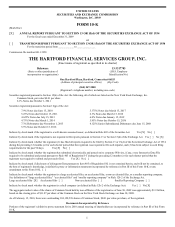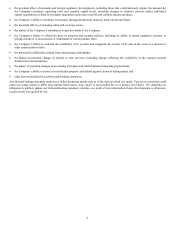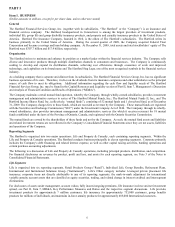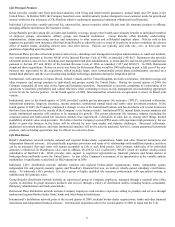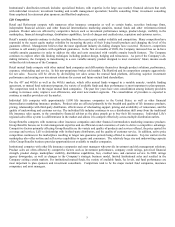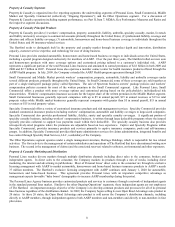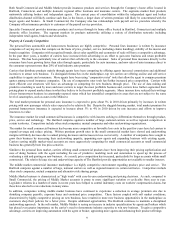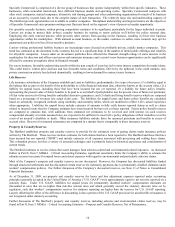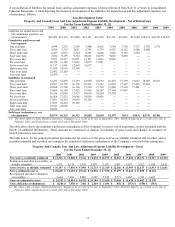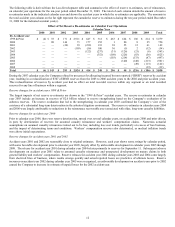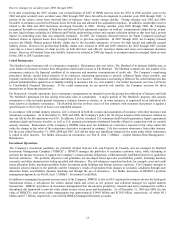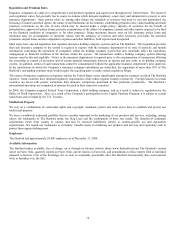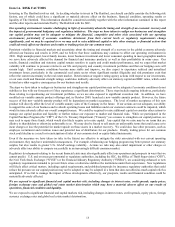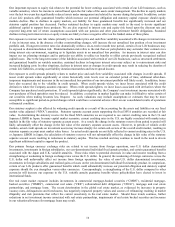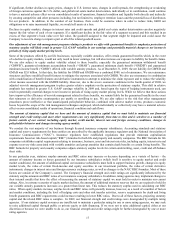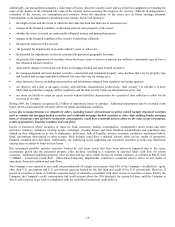The Hartford 2009 Annual Report Download - page 9
Download and view the complete annual report
Please find page 9 of the 2009 The Hartford annual report below. You can navigate through the pages in the report by either clicking on the pages listed below, or by using the keyword search tool below to find specific information within the annual report. 9
Both Small Commercial and Middle Market provide insurance products and services through the Company’ s home office located in
Hartford, Connecticut, and multiple domestic regional office locations and insurance centers. The segments market their products
nationwide utilizing brokers and independent agents. The current pace of consolidation within the independent agent and broker
distribution channel will likely continue such that, in the future, a larger share of written premium will likely be concentrated with the
larger agents and brokers. In Small Commercial, the Company also has relationships with payroll service providers whereby the
Company offers insurance products to customers of the payroll service providers.
Specialty Commercial provides insurance products and services through its home office located in Hartford, Connecticut and multiple
domestic office locations. The segment markets its products nationwide utilizing a variety of distribution networks including
independent retail agents, brokers and wholesalers.
Property & Casualty Competition
The personal lines automobile and homeowners businesses are highly competitive. Personal lines insurance is written by insurance
companies of varying sizes that compete on the basis of price, product, service (including claims handling), stability of the insurer and
brand recognition. Companies with recognized brands, direct sales capability and economies of scale will have a competitive advantage.
In the past three years, a number of carriers have increased their advertising in an effort to gain new business and retain profitable
business. This has been particularly true of carriers that sell directly to the consumer. Sales of personal lines insurance directly to the
consumer have been growing faster than sales through agents, particularly for auto insurance, and now sales of auto insurance direct to
the consumer represent more than 20% of total industry auto premium.
Carriers that distribute products mainly through agents have been competing by offering agents increased commissions and additional
incentives to attract new business. To distinguish themselves in the marketplace, top tier carriers are offering on-line and self service
capabilities to agents and consumers. More agents have been using “comparative rater” tools that allow the agent to compare premium
quotes among several insurance companies. The use of comparative rater tools has further increased price competition. Carriers with
more efficient cost structures will have an advantage in competing for new business through price. The use of data mining and
predictive modeling is used by more and more carriers to target the most profitable business and, carriers have further segmented their
pricing plans to expand market share in what they believe to be the most profitable segments. Many insurers have reduced their writings
of new homeowners business in catastrophe-exposed states which has intensified competition in areas that are not subject to the same
level of catastrophes, such as states in the Midwest.
The total market premium for personal auto insurance is expected to grow about 3% in 2010 driven primarily by increases in written
pricing with new passenger vehicle sales expected to be relatively flat. Despite the sluggish housing market, total market premium for
personal homeowners insurance is expected to increase about 3% to 4% in 2010 driven by rate increases and efforts to improve
insurance-to-value.
The insurance market for small commercial businesses is competitive with insurers seeking to differentiate themselves through product,
price, service and technology. The Hartford competes against a number of large, national carriers as well as regional competitors in
certain territories. Competitors include other stock companies, mutual companies and other underwriting organizations.
The market for small commercial business has become more competitive as favorable loss costs in the past few years have led carriers to
expand coverage and reduce pricing. Written premium growth rates in the small commercial market have slowed and underwriting
margins will likely decrease due to earned pricing decreases and increases in loss cost severity. A number of companies have sought to
grow their business by increasing their underwriting appetite, appointing new agents and expanding business with existing agents.
Carriers serving middle market-sized accounts are more aggressively competing for small commercial accounts as small commercial
business has generally been less price-sensitive.
Similar to the personal lines market, carriers offering small commercial products have been improving their pricing sophistication and
ease of doing business with the agent including the use of predictive modeling tools and automation to speed up the process of
evaluating a risk and quoting on new business. As a result, price competition has increased, particularly for larger accounts within small
commercial. The relatively large size and underwriting capacity of The Hartford provide opportunities not available to smaller insurers.
The middle market commercial insurance marketplace is a highly competitive environment regarding product, price and service. The
Hartford competes against a number of large, national carriers as well as regional insurers in certain territories. Competitors include
other stock companies, mutual companies and alternative risk sharing groups.
Middle Market business is characterized as "high touch" with case-by-case underwriting and pricing decisions. As such, compared to
Small Commercial, the pricing of Middle Market accounts is prone to more significant variation or cyclicality from year to year.
Legislative reforms in a number of states in recent years have helped to control indemnity costs on workers' compensation claims, but
these have also led to rate reductions in many states.
In addition, companies writing middle market business have continued to experience a reduction in average premium size due to
shrinking company payrolls, exposure bases and continued price competition. These factors coupled with soft market conditions,
characterized by highly competitive pricing on new business, have resulted in more new business opportunities in the marketplace as
customers shop their policies for a better price. Despite additional opportunities, The Hartford continues to maintain a disciplined
underwriting approach. In the soft market, Middle Market is seeing an increase in industry specialization by agents and brokers which
has placed even greater importance on the carrier’ s need to demonstrate industry expertise to win new business. To gain a competitive
advantage, carriers are improving automation with the agent or broker, appointing more agents and enhancing their product offerings.

